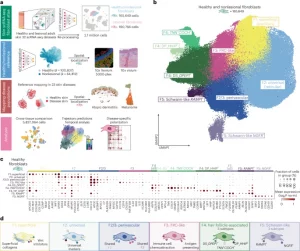Fibroblasts are structural cells that shape tissue architecture and immune environments, but their heterogeneity has been difficult to capture. Using single-cell RNA sequencing and spatial genomics, researchers created a comprehensive atlas of human skin fibroblasts, profiling both healthy skin and 23 different skin diseases, with cross-comparisons to 14 other tissue diseases (Figure 1).

Figure 1: Identification of fibroblast subtypes in healthy skin. a, Overview of study methodology, including skin atlas integration to delineate fibroblasts, construction of a healthy/nonlesional reference, mapping of 23 diseases to the healthy reference atlas and downstream analysis for cross-tissue comparison. b, Uniform Manifold Approximation and Projection (UMAP) of healthy and nonlesional skin fibroblasts colored by fibroblast subtype. DS, dermal sheath; DP, dermal papilla. c, Dotplot of marker gene expression for healthy fibroblasts. ‘All’ indicates a marker for a general population, but which contains subtypes. Supplementary Data Fig. 1a provides additional differentially expressed genes for fibroblast subtypes. d, Summary of skin fibroblast subtypes in healthy steady-state tissue. Illustrations in a and d were partly created using BioRender.com.
The team identified six major fibroblast subtypes in healthy skin and three disease-associated subtypes. Importantly, they characterized two immune-related subtypes that were conserved across multiple tissues:
- F3 (fibroblastic reticular cell-like fibroblasts, CCL19+CD74+HLA-DRA+) – predicted to maintain the perivascular immune niche in superficial skin.
- F6 (inflammatory myofibroblasts, IL11+MMP1+CXCL8+IL7R+) – enriched in early skin wounds, inflammatory diseases with scarring risk, and cancers; predicted to recruit neutrophils, monocytes, and B cells.
By mapping fibroblast location and gene signatures, the study links these subtypes to immune recruitment and tissue remodelling in inflammation, scarring, and cancer. The atlas also introduces a harmonized nomenclature for fibroblasts across skin health, disease, and other tissues, providing a reference framework for future translational studies.
This work highlights fibroblasts as active immune regulators, not just structural cells, and points to shared fibroblast programs across diseases and tissues that could be targeted in therapies for fibrosis, chronic inflammation, and cancer.
Journal article: Steele, L., et al. 2025. A single-cell and spatial genomics atlas of human skin fibroblasts reveals shared disease-related fibroblast subtypes across tissues. Nature Immunology.
Summary by Stefan Botha










